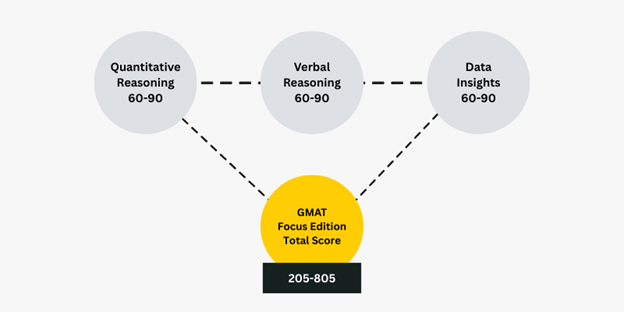How to Calculate Your GMAT Score

Confused by how your GMAT score is actually calculated? You’re not alone.
With adaptive testing, scaled scores, and a new scoring range in the GMAT Focus Edition, it’s easy to feel lost.
Always keep in mind the end goal: the GMAT score that makes you a competitive applicant at your target schools.
In this guide, you’ll learn how to calculate your GMAT score, how each section contributes, what your percentile means, and how schools interpret your results.
Because once you understand the math behind the score, you can study smarter and aim higher.
Overview of GMAT Scoring Methodology
The GMAT Focus Edition comes with a new format and a new scoring scale.
If you’re wondering how to calculate GMAT score now, here’s a quick and easy breakdown:
- Total GMAT Score Range
The GMAT Focus Edition scores range from 205 to 805, going up in steps of 10.
All scores end in a 5—so you’ll see scores like 655, 705, or 775, not 650 or 700. This small change helps schools tell apart Focus Edition scores from the older version.
- What Counts Toward Your Total
Your total score is based on three sections: Quantitative Reasoning, Verbal Reasoning, and Data Insights. Each section is scored separately on a scale of 60-90, so no one area is more important than the others.
- Goodbye AWA, Hello Data Insights
The Analytical Writing (AWA) section is gone in the Focus Edition, so no essay writing.
The old Integrated Reasoning section has now become Data Insights, and here’s the key difference: it now counts toward your total score (it didn’t before).
That said, your GMAT Focus total score (from 205 to 805) is based only on how you perform in Quant, Verbal, and Data Insights. That’s it.
No essays, no extra sections. Just three core areas that all get equal weight.
Raw Score vs Scaled Score vs Percentile — What’s the Difference?
When you finish the GMAT, you’ll see numbers on your score report, like your section scores and total score.
But what do those numbers really mean? Here’s a quick breakdown:
Raw Score – The Basics
Your “raw” performance is the number of questions you answered correctly (taking into account the GMAT’s adaptive difficulty).
Because the GMAT is computer-adaptive, you cannot calculate your score by just counting correct answers, which questions you got right (and at what difficulty level) matter a lot.
The GMAT scoring algorithm looks at three main factors although the exact formula is not disclosed by GMAC:
- The number of questions you answered
- How many you answered correctly, and
- The difficulty and other statistical parameters of those questions
Scaled Score – What You Actually See
Your scaled score is what shows up on your score report for each section (Quant, Verbal, Data Insights).
These scores are based on your raw performance but are adjusted using the GMAT algorithm, so they reflect your skill level, not just the percentage of correct answers.
Then, those three section scores combine into your total score, which ranges from 205 to 805, in steps of 10, always ending in a 5 (e.g., 655, 705, etc.).
Percentile Ranking – How You Stack Up
Your percentile indicates how your score compares to other test takers. It answers the question, “What percentage of test takers did I score higher than?”
For example, a 75% percentile means you did better than 75% of GMAT examinees (and 25% did better than you).
Percentiles are based on rolling data from recent years; for the Focus Edition, GMAC uses the last three years of exam data to update percentiles.
Percentiles may shift over time as more Focus Edition scores are added, but scaled scores are stable and directly comparable.
Importantly, business schools pay close attention to percentiles to interpret your performance.
In the old GMAT, many students aimed for a 700 as the magic number. But on the new GMAT Focus Edition, that same level of performance now shows up as a 645.
So yes, the numbers look lower, but that doesn’t mean your score is worse.
It’s just a different scale. Business schools understand this and focus more on your percentile ranking, not just the number.
That said, 645 on the GMAT Focus can be just as strong as a 700 on the old GMAT.

GMAT Focus Edition Scoring Breakdown (Post-2023)
The GMAT Focus Edition comes with a new score scale and updated section structure.
Here’s the GMAT score chart:
| Section | Questions & Time | Scaled Score Range |
| Quantitative Reasoning | 21 questions in 45 minutes (Problem Solving only) | 60 to 90 (1-point steps) |
| Verbal Reasoning | 23 questions in 45 minutes (Reading Comp. + Critical Reasoning) | 60 to 90 (1-point steps) |
| Data Insights | 20 questions in 45 minutes (Integrated Reasoning + Data Analysis) | 60 to 90 (1-point steps) |
| Total Score | Combines all 3 section scores | 205 to 805 (10-point steps, always ends in 5) |
Here are some important things you should know:
- Quant, Verbal, and Data Insights each carry equal weight in your total score. No section is “heavier” than the others.
- Wrong answers don’t subtract points, but they can hold your score back.
- Unanswered questions hurt more than guesses; always try to finish every section.
And if time management or tricky questions are slowing you down, don’t worry – that’s exactly what Gurutor is built for.
Unlike a GMAT tutor, it’s with you 24/7, offers step-by-step guidance, flags mistakes as they happen, uses official GMAT material, and prioritizes efficiency, not volume.
The takeaway? To hit your target score, aim for solid performance across all three sections.
Section-Wise GMAT Score Calculation
Understanding GMAT section scores can help you identify where to focus your prep and how close you are to the top of the scale in each part.
Here’s the GMAT focus edition score breakdown, section-wise:
1. Quantitative Reasoning
You’ll be tested on key concepts from arithmetic, algebra, and basic geometry, all wrapped into real-world-style word problems.
- Score range: 60-90
- Score intervals: 1
- Standard error of measurement: 3 points (This means if your score is 75, your true ability might fall within ±3 points, i.e., between 72–78).
Your score is based on these three factors:
- The number of questions you complete
- Whether the answers are correct or incorrect
- The difficulty level and other parameters of the questions you answer
The goal? To measure how well you reason with numbers and solve problems under time pressure.
It’s not just about the number of right answers.
For example, getting 18 out of 21 questions correct could give you different scores depending on the difficulty of the questions you got right.
2. Verbal Reasoning
The Verbal Reasoning section of the GMAT Focus Edition no longer includes Sentence Correction questions.
Instead, it focuses on your ability to read, analyze, and reason, which is good news for non-native speakers who struggled with fine-tuned grammar rules in older versions of the exam.
You’ll see a mix of:
- Reading Comprehension (RC): Understand main ideas, draw inferences, interpret tone, etc.
- Critical Reasoning (CR): Evaluate arguments, spot assumptions, strengthen/weaken conclusions.
Given this, the verbal section now rewards reading precision and critical thinking over memorized grammar rules.
Your score depends on:
- The number of questions you answer
- Whether the answers are correct or incorrect
- The difficulty level and parameters of the questions answered
For example, two test-takers might both get 5 questions wrong, but end up with very different scores. If one person missed only very hard questions and did well otherwise, they might still score in the low 80s.
But if the mistakes were on easier or medium questions, that person’s score might drop into the 70s.
So it’s not just about how many you miss, but which ones you get wrong that matters.
3. Data Insights
This section replaces the old Integrated Reasoning, which has been expanded and made more important.
It includes a mix of question types such as Data Sufficiency (adapted from Quant), as well as Multi-Source Reasoning, Table Analysis, Graphics Interpretation, and Two-Part Analysis (all reminiscent of the former IR questions).
Data Insights measures your ability to analyze and interpret data in various formats and solve problems using integrated reasoning skills.
Also, a basic on-screen calculator is available in this section (useful for computations on data tables).
Your score is based on:
- The number of questions you answer
- Whether the answers are correct or incorrect
- The difficulty and other parameters of the questions answered
But here’s a key detail: Many DI questions are multi-part (e.g., two statements or inputs).
To earn credit, you must get all parts correct; no partial credit is given. That means one small error can cost you the entire question.
Because Data Insights pulls from both math and verbal skills, it can feel different depending on your strengths:
- Strong at Quant? You may breeze through calculations and logic.
- Better at Verbal? You’ll shine in written analysis and source comparison.
- Need both? Practice interpreting visuals and reasoning with precision.
Now that DI impacts your total score, a weak performance here will lower your overall GMAT. On the flip side, a strong DI score can significantly lift your total.
And business schools will see it. Data Insights reflects the kind of data literacy and real-world problem-solving skills that modern MBA programs value.
So if you’re retaking the GMAT, it’s essential to give this section your full attention.
How Schools Interpret Your GMAT Score
Your GMAT score plays a key role in MBA admissions, but how do admissions committees actually interpret it?
While your Total Score is the headline number, schools also look closely at your percentile and calculate section-wise GMAT score to understand your academic strengths and readiness for a rigorous MBA program.
Here’s what really matters:
Total Score Is the First Filter
The Total Score (205–805 on the GMAT Focus Edition) is the number that admissions teams often consider first.
The GMAT score chart gives them a quick sense of your academic potential.
- Top schools (e.g., Harvard, Wharton, Booth) often report average GMAT scores around 720 on the old scale, which translates to roughly 675 on the Focus Edition (around the 95th percentile).
- A 645 on the Focus Edition, while lower in absolute terms, is actually about the 88th percentile, a very strong score. Schools have adapted to this new scale and adjusted their expectations accordingly.
- Remember, top programs admit across a range. A few points below the average won’t disqualify you, especially if the rest of your application is strong.
Section Balance Matters More Than You Think
While the total score grabs attention, admissions committees often examine section-level performance, especially in Quant and Verbal.
Thus, a candidate with an unbalanced score might raise concerns about communication or classroom contribution, despite possessing strong quantitative skills.
Ideally, aim for all section scores in a similar high range (e.g., around 80+). A single weak section can stand out more than a modest total score.
Additionally, because the Focus Edition uses a new scoring scale, many schools are now placing greater weight on percentiles rather than raw scores.
So if your score looks “low” (e.g., 610), don’t panic. Check the percentile; you might still be above average for many programs.
Good luck with your GMAT prep!
If you want a smarter, more strategic way to reach your target score, try Gurutor. It’s built to feel like a top tutor is guiding you through every step, with real-time feedback and official GMAT content.
Start today and study like a 90th percentile scorer!
FAQs About How to Calculate GMAT Scoring
How is the GMAT score calculated from the raw score?
The GMAT Focus Edition total score ranges from 205 to 805 and is based on your scaled section scores in Quantitative, Verbal, and Data Insights, each scored between 60 and 90. The scoring algorithm is adaptive and proprietary, meaning it doesn’t just count how many questions you got right.
Instead, it considers the difficulty level of the questions and your performance across each section. So, the number of correct answers alone doesn’t determine your final score.
What’s a good GMAT score?
A good GMAT score depends on your target schools. Generally, scoring above the 50th percentile (around 555 on the Focus Edition) is considered decent. However, for top MBA programs, a good score typically means landing in the 85th to 90th percentile or higher, which translates to a score of around 630–650 or higher on the Focus scale.
Do AWA and IR affect your total GMAT score?
No, the AWA and old IR scores don’t count toward your GMAT total. In the Focus Edition, the AWA section has been removed, and the Integrated Reasoning (IR) section is now part of your total score through the new Data Insights section.
Can you improve GMAT score with just one section?
Yes, improving even one section can increase your GMAT total score, but you should be strategic about it. Since the total score is a function of all three section scores, raising any one of the section scores will raise your total.
